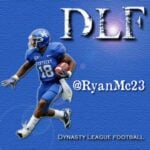Keep Dynasty Weird: The Second Chance Dynasty League

One of my recent passions when it comes to dynasty fantasy football is educating myself about varying unique league concepts. Some might even call these leagues weird. If that’s true, I want to keep dynasty weird. In this series, I will profile some leagues that have been based on a unique concept. I’ve created some of these leagues and some I have been a part of, but all have something special about them.
It happens every off-season to me and many other dynasty football players. With real game action put on hold, I scratch the fantasy itch by joining new leagues. Early in my fantasy football career, each January I would embark on my journey to find the perfect dynasty league. Most often, this would result in a short-term stay in a league that I could tell was going nowhere fast. Finally, I came to the realization that if I wanted to find the right league for me, the best option was to create the league myself. That is how I became a commissioner.
Early in this off-season, a friend of mine asked me some advice regarding an established dynasty league. But, his question was a unique one. He was not asking for help on a difficult trade decision, nor was he looking for a late round sleeper in his rookie draft. In his league, there were two open teams. The previous owners of these teams had abandoned them. Unfortunately, this is a fairly common practice in online dynasty leagues. Owners usually have a variety of excuses about why they are choosing to leave a league, but it usually boils down to the quality, or lack thereof, of their team. When this issue presents itself, a commissioner often has a challenging task set before him to find new owners for the available teams. Clearly, if there is just a lone open team, the choice is clear: find a new owner willing to take on the team as it is. When there are multiple teams in need of someone to guide them, other avenues become available. One of the most popular recent ways to entice new owners to join your established league is by offering them the option to participate in a dispersal draft.
When conducting a dispersal draft, all assets (players and future rookie picks) from a set group of teams, usually two or three, are made available to draft. The typical way this is managed is to allow all new incoming owners to participate. While owners already in the league may have the option to make trades during the dispersal draft, they are not otherwise allowed to restock their team in this way.
This is the exact situation my friend was asking about. As I mentioned, his league had multiple openings and would be using a dispersal draft for the incoming owners. The twist was there were a couple of owners who had poor teams. These owners evidently saw this as an opportunity to reset the clock and give them a chance to be competitive in short order. These two owners requested the chance to participate in the upcoming dispersal draft by relinquishing their rights to all of their players. The league commissioner was considering their request and even opened things up to the other league members to determine if other current owners were interested. This is what led my friend to ask for my advice. He has a strong, contending team in this league, so he was not considering participating in the potential dispersal draft. Instead, he was wondering if this was a good thing for the league. An even more important question…was this fair? Owners like my friend and others had spent their time in the league making trades, scouring the waiver wire and studying each rookie class as they prepared for drafts, and had done each of these successfully. Would it be fair to allow teams who had been less successful, for whatever reason, to get a second chance like this?
My immediate and gut response was “no.” Allowing something like this was setting a bad precedent, which the commissioner would be reminded of over and over each off-season. Fortunately for the future of the league, the commissioner and the owners decided against allowing existing teams from participating in their dispersal draft, limiting it to only the new owners taking over abandoned teams.
Over the next couple of days, I continued to focus on this idea. I conducted an internal debate about the fairness of this possibility, allowing current owners to essentially dump their team and start fresh. The more I considered the potential of this, the more I realized what I liked least about it for my friend’s league is that this involved a rule change well after the league had already been established. Each year in my dynasty leagues, we have a time for discussion and voting on possible rule changes, but there are some rules that should not be changed or altered in any way after the startup draft. I’ll touch more on some of these sacred rules in an upcoming article. What stood out though was that this rule might have worked if owners had just known about it from the start of the league.
In analyzing this possible rule, I began to weigh the pros and cons of affording owners a second chance as a first draft. I discussed with my friend in the aforementioned league and also consulted with some other dynasty players whose opinions I value greatly. What came from this was a solid list of reasons a league like this might just work.
First, this would help to retain owners. Many times, sadly, owners simply leave a league when their team is not competitive year after year. Giving owners the flexibility to start fresh could help to keep these owners in the league for the long-term. You might argue an owner who would bail on the league due to the state of their team is not an owner you’d want to keep anyway (and you’d be correct), but there are often quality owners that get stuck with a bad team after a series of unforeseen events, be it injuries or off the field issues, as we’ve recently been cruelly reminded of. Allowing an owner to participate in a dispersal draft could help keep those quality owners in your league.
Another positive side effect of this idea is it allows for even more strategy when conducting a startup draft or playing out the regular season. We all have been a part of startup drafts when some teams are clearly in “win now” mode grabbing every high performing veteran available, while other owners want the all of the youngest and most hyped players they can get, which usually results in multiple losses in years one and two. Understanding each owner has a chance to hit the proverbial reset button would allow for an even wider variety of strategies, specifically in year one.
Finally, another pro is this format could help attract new owners to the world of dynasty football. There are millions and millions of fantasy football players, but the large majority only play in yearly redraft leagues and for whatever reason, have yet to venture into a dynasty league format. In the past, a small keeper league has been a successful bridge between redraft and dynasty and has helped bring many players into dynasty leagues, but this would truly give new owners a feel for dynasty, which allowing an “out” if needed.
With all this in mind, I decided this was a format I wanted to test and find if it could truly work. The downside is it would take a full year or more to come to a conclusion, since the first season would be played out as any other dynasty league would.
I ventured to Twitter to find eleven other dynasty players willing to try out a new concept and what I found was shocking. With almost no information about the unique format of the league, I received tremendous response. So much so, that I created a league of 24 teams, featuring two twelve team conferences with a separate player pool. And thus, the Second Chance Dynasty League was formed.
Soon after this, the startup draft was held, and while it may not be evident, there were multiple comments during the draft alluding to the possibility of using that second chance option a season from now.
Here are the specific rules created and which the league was based on:
- During the off-season, each owner will have the option for a second chance dispersal draft.
- Any owners opting for the second chance will relinquish the majority of their assets, including all players and rookie picks.
- The only asset owners will retain is their blind bid waiver money.
- Owners will declare their decision to opt for the second chance by emailing a third party not involved in the league.
- Once the deadline passes, the commissioner will reveal the teams choosing the second chance.
- If more than one team in each conference opts for the second chance, all assets will be dropped and will be part of the second chance dispersal auction
- If only one team in each conference opts for the second chance, the two owners will have the option to completely switch teams and conferences. Both parties would have to agree to this switch.
I can’t wait to check back in a year from now and let everyone know how the second chance rule worked.
As I mentioned earlier, I would not be comfortable enacting this rule in current dynasty leagues, but I think with a solid group of dedicated owners, it would be a unique twist that would add another element of strategy. In fact, our friend Scott Atkins liked my idea so much he used it as part of the basic rules for the Dynasty World Championship, sponsored by FFToolbox.
If you have questions about the rules or format of the Second Chance Dynasty League, please post them below or contact me on Twitter @RyanMc23
- DLF’s April 1QB Trade Value Chart - April 24, 2024
- Monday Mocks: Expert 2024 Rookie Mock Draft - April 22, 2024
- Monday Mocks: 2024 Landing Spots - April 15, 2024


































































